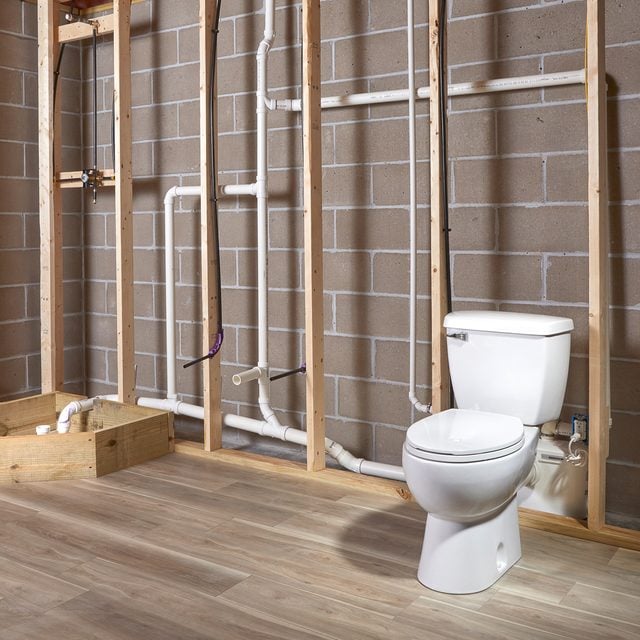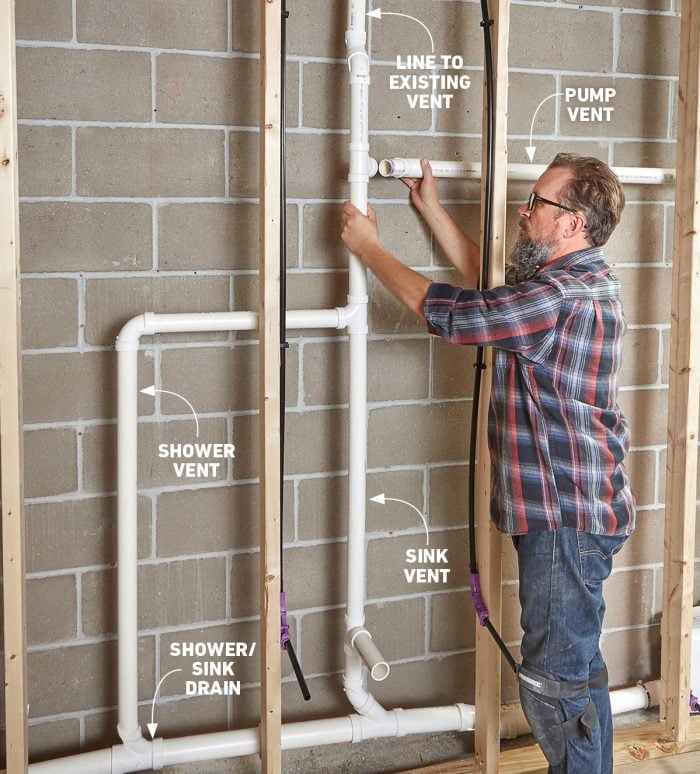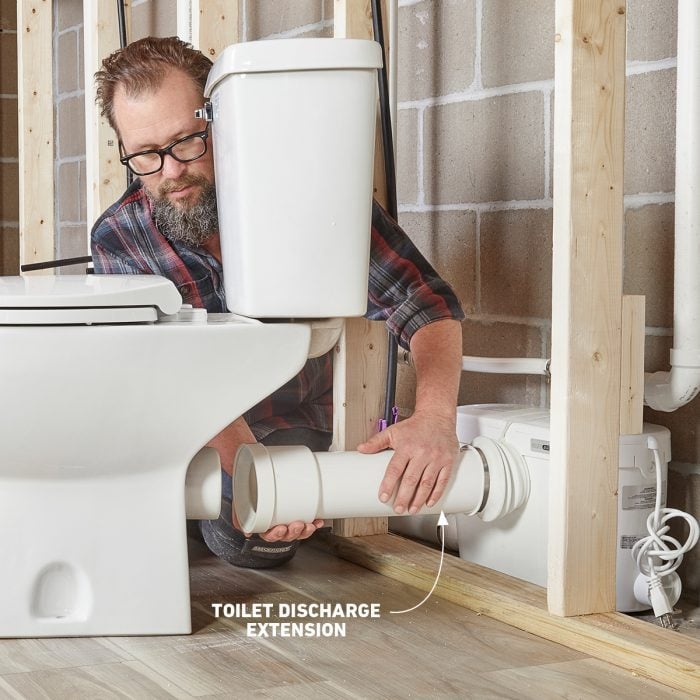How To Put A Shower In A Basement
How to Add together a Bathroom to a Basement the Easy Mode
Add a bathroom in your basement without busting up the concrete floor.
![]() Time
Time
Multiple Days
![]() Complexity
Complexity
Intermediate
![]() Price
Price
$1200-1300
Introduction
Need another full bathroom in your dwelling? Here'due south a way to install one in your basement with a different kind of toilet and plumbing.
Tools Required
Materials Required
- Framing lumber
- GFCI outlet
- PVC agglutinative
- PVC pipe
- Saniflo SaniAccess 3
The addition of a full bath with a shower, sink and toilet can be a huge improvement to whatever home, peculiarly if you have only i bathroom and a growing family. It can also exist a huge, expensive job.
Upflow bath systems simplify the plumbing of a basement bathroom, putting this valuable home improvement job within reach of a DIYer.These systems include a macerator/pump that can be tucked into a wall direct behind a rear-discharge toilet.
All the fixture drains flow to the macerator/pump, which grinds solids and then pumps waste upward to connect to your main drain line, instead of relying on gravity. Shower and sink drains practice utilize gravity to attain the pump, and those are piece of cake installations.

What is a Macerating Toilet?
Think of it every bit like to a garbage disposal in your sink. In a macerating toilet, waste is channeled to the macerator/pump, which reduces solids to be easily pumped through a iii/4-in. discharge pipe.
Our arrangement, the SaniAccess 3 from Saniflo, includes a rear-discharge toilet and a macerator/pump with fittings. Yous'll supply the rest of the standard plumbing pipes and fittings.
System Advantages
The biggest advantage of an upflow arrangement is not breaking up a physical floor to run drains. In that location are other advantages, besides.
Beginning, the discharge line is much smaller than a standard drain line, then you can fit it into places where a standard bleed might not work. 2d, you can install a bathroom anywhere. Yous don't demand to be concerned with how the toilet bleed aligns with existing drain lines in your dwelling.
Run into the Proficient
Carmen Bossi, the president/founder of Saniflostore.com
Project footstep-by-pace (ten)
Step 1
Identify the Macerator/Pump
Gear up the macerator/pump in place behind the wall framing. The unit needs to be on the same level every bit the toilet. Install the prophylactic anxiety and secure the pump to the floor.
If you're in a cold climate, allow space between the pump and the wall for insulation. Insulation in front of the pump will aid dampen the minimal noise from the macerator/pump.

Step 2
Install a GFCI Outlet
The macerator/pump needs its own GFCI outlet. Install the outlet inside the wall framing, nigh the pump. The outlet needs to be within 12 inches of an access panel and facing the room. Be sure to check local codes before installing this outlet.

Footstep 3
Build the Shower Pan Footstep-Up
With your shower plumbing in hand, calculate the peak of the platform, including the P-trap too as a 1/four-in. driblet per foot of horizontal run to the pump. The minimum height is six inches, and that's usually plenty depending on your P-trap and the altitude to the pump. You may demand to add an extra pace, depending on the finished superlative.
To lower the platform pinnacle, chip out some concrete for the P-trap. If your basement has low ceilings, you may need to consider a tub instead of a shower.

Footstep iv
Connect the Shower and Sink Drains
Hook up the shower drain and run the piping into the wall. Use an elbow to turn the pipe toward the pump. In our bathroom, the sink is between the shower and the toilet, and then we tied in the sink drain on the way to the pump.
The pump has a drain entrance on both sides, and so you can configure your bathroom even so you like. In our case, nosotros used a provided plug to cap the entrance on the other side of the pump.

Step five
Install the Vents
Along the drain line, y'all'll install a vent for each fixture. Connect these vents and tie them into the vent system on your existing plumbing. Mechanical vents won't work with this organization; only a free air vent can be used.

Pace 6
Connect the Discharge to the Pump
Slip the flexible discharge tube onto its port on the pump and secure it with a hose clamp. At the terminate of the tube, yous can install a shutoff brawl valve. If you lot e'er need to remove the pump, that valve will prevent backflow.
Afterwards the first difficult 90-degree plough from the pump, whatsoever turns in the discharge piping demand to be sweeping — no more hard 90s. Use a sweep elbow or ii 45-degree elbows instead.

Stride 7
Connect the Discharge to the Principal Sewer Line
The discharge line can run horizontally at first, but for no more than 18 inches before information technology turns vertically. After the showtime vertical turn, the pipe tin run horizontally once more but not make another vertical or diagonal turn. The total run from the pump to the primary sewage line must exist a minimum of iii feet.
The easiest place to necktie into the main drain is at a cleanout using a reducer fitting. If that'due south not an choice, you can install a Y-fitting (not a T-fitting) on any horizontal run, just the discharge must enter the pipage from the meridian or side. No other lines tin can feed into the discharge from the pump.

Stride viii
Discharge Options
If you have a cleanout in a convenient spot, you can connect the belch there. But remove the plug and install a reducer to connect the 3/4-in. belch piping.
If your drains are steel piping, you'll need to cut out a section and install a Y-plumbing equipment using mission clamps. Y'all can't apply the type that just have hose clamps, though — only the fully banded type.

Step ix
Connect the Toilet
Set up the toilet into position, then connect the flexible boot to the toilet'southward discharge port. Next, connect the kicking on the other end to the pump. Make certain the connectedness kicking faces the right direction. Nil ties keep the kick in place, as this is a drain, not a pressurized supply line.
- Pro tip: Making a direct cut on a large-bore pipe starts with an accurate line. Wrap a piece of cardboard with ane directly edge around the pipage and marking your line with a Sharpie.
- Pro tip: To brand the cutting, first saw all the style around the piping just plenty to remove the mark. Go on sawing a little deeper each time around until you're through the pipage.

Footstep 10
Install the Toilet
Mark holes on the floor through the holes on the toilet base of operations. Slide the toilet out of the way, then drill the holes for the supplied concrete anchors using a correct size masonry bit. Slide the toilet back into position, and then install the lag screw anchors.
Use shims under the toilet as needed to keep it from rocking. Be conscientious not to overtighten the bolts; you can crack the toilet.

Originally Published: November 09, 2022
Source: https://www.familyhandyman.com/project/add-basement-bathroom/


0 Response to "How To Put A Shower In A Basement"
Post a Comment